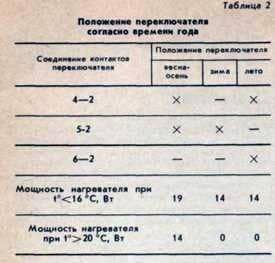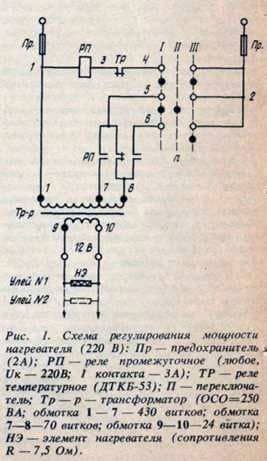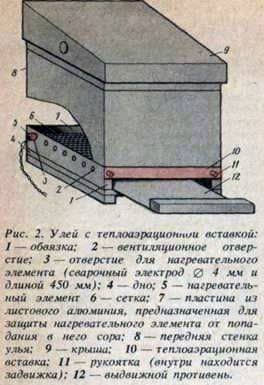
For the winter period, as is known, the bee family requires 8 to 15 kg of feed, depending on the climatic zone and wintering conditions. The amount of feed intake, brood heating, wax release, evaporation of water from nectar depends essentially on the ambient temperature. It follows that one of the effective ways to save feed is the maintenance of bee colonies in heated hives.
As practice has shown, in this way it is possible to save up to 5 kg of fodder during wintering, up to 7 for brood rearing, and up to 3 kg of feed for evaporation of water from nectar. Why is the effective intake of bee colonies in heated hives not always an application? The reasons for all the setbacks are that the person, interfering with the microclimate of the bee’s dwelling, creates in him an unnatural thermal regime.
The method of artificial heating of the nest with the automatic maintenance of a constant temperature has, in my opinion, disadvantages.
Firstly, bees do not feel a diurnal temperature change, they are disoriented at the time of departure for a bribe. Secondly, the heat energy input can be insufficient or excessive, inefficient or harmful, not to mention the fact that the beekeeper experiences considerable difficulties in the device of individual automation and the choice of the location of the temperature sensor.
When excessive thermal energy is introduced, conditions close to the incubator are created, that is, the bees are almost completely freed from the heating of the brood. To deprive the bees of the physiological need to generate heat means to doom them to death, since their flying abilities are reduced.
From this follows the conclusion: it is necessary to create a thermal regime close to natural in the hive by means of a dosed supply of thermal energy, taking into account the amount of expected brood and the ambient temperature.
I propose a method for calculating the required heater power for a given period of the year:
P = K1 X K2 X H (26 њ – t њ),
Where P is the power of the heater, W;
K1 = 5,1 – coefficient, taking into account the energy value of honey;
K2 = 0,01 ± 0,012 – coefficient that takes into account the breed of bees and the construction of the hive;
H – the amount of expected brood at the given time of year (thousands of cells);
26 њ – ambient temperature at which the minimum feed consumption is noted;
T њ C is the average multi-year ambient temperature for a given period of the year (according to the reference book).
It is more convenient to take a calendar month for the billing period.

Due to the fact that the power consumption of the heater varies little by month (Table 1), it is more convenient to switch the heater output depending on the season to simplify the electrical control scheme (Table 2).

Due to the fact that diurnal fluctuations in ambient temperature vary widely (in the daytime it is high and at night it is low), then at a temperature above the average monthly one, in order not to overheat the nest, the heater power automatically decreases to the value corresponding to the average maximum multiyear secondary voltage of the transformer by switching the primary transformer coils of the transformer by an intermediate relay RP when the contacts of the temperature relay TP open.

The sensor with the installed power supply is located on the apiary in a place convenient for laying the wires.
The thermal energy released by the heater can not completely compensate the energy capacity of an equivalent amount of food. The matter is that bees, economically spending food, heat that part of the volume of the nest where the brood is, and the heat emitted by the heater is distributed throughout the entire volume of the hive.

Thanks to the heat-aeration insert, artificial heating compensates up to 40% of the estimated feed consumption for brood heating. This is enough to not deprive the bees of the physiological need to generate heat, to feel the diurnal course of temperature changes, to have a beneficial effect on the development of the family and honey production.
The calculated capacity of the heater may differ from the actually optimal for a particular bee family by 10-15%, but these fluctuations have no significant effect on the development and productivity of bees.
For many years I have established that winter heating ensures the safety of bee families. They save up to 5 kg of feed. There is no disastrous dampness in the nest in the thaw due to better ventilation. There is a small load due to the late flight of bees in the fall and a lower intake of fodder in winter, no shortcomings noted.
With spring heating, the humidity in the hive is reduced, there is no mold, little podsmora – the bees quickly render it. With the advent of nectar in nature, families begin to actively develop. The lack of spring heating lies in the fact that because of the decrease in humidity, the bees fly around and grow brood almost a month later compared to families with normal maintenance. It is advisable to put in-bowl drinkers.
With summer heating, the proposed heat-aeration insert provides additional ventilation and compensation of heat leaving the hive, yielding savings of 3-5 kg of honey.
Autumn heating allows the bee family to increase more bees in the winter, contributes to late flying of the bees before wintering begins.
After the transfer of the contents of bee colonies to heated hives, I do not make a spring audit, I do not give top-dressing either in the spring or in the autumn, I do not treat the treatment, since I do not find varroatosis and other diseases. From the family I get an average of 30-35 kg of honey. On neighboring apiaries, amateur beekeepers get 25-30 kg with sugar.
I think that you can get more honey (some families give up to 60 kg).
A detailed description of the heated hive (SU 1428329A1) can be obtained from the patent department of any regional library.
Кормовые рамки для пчел. Луговой медонос.
Hibernation of bees